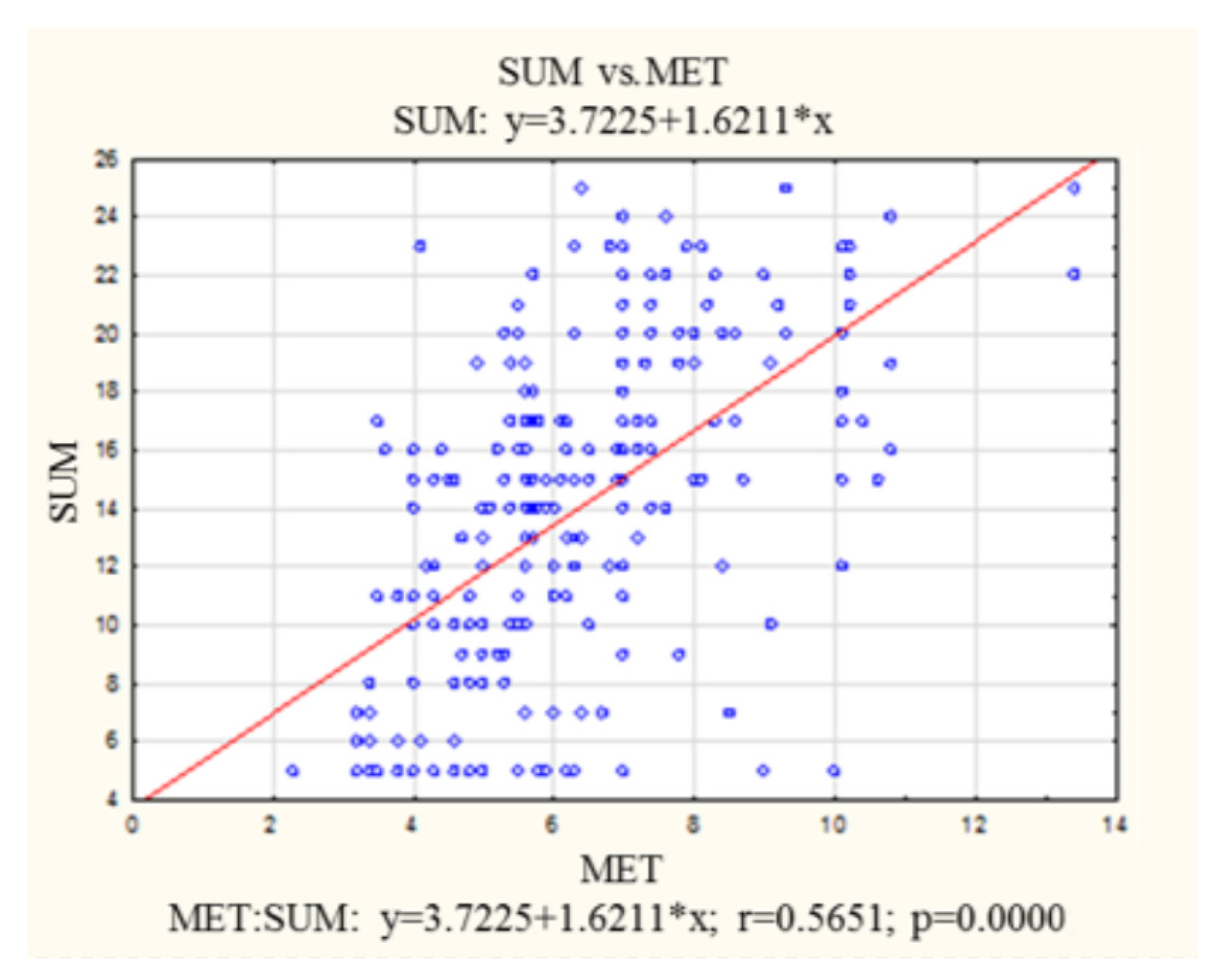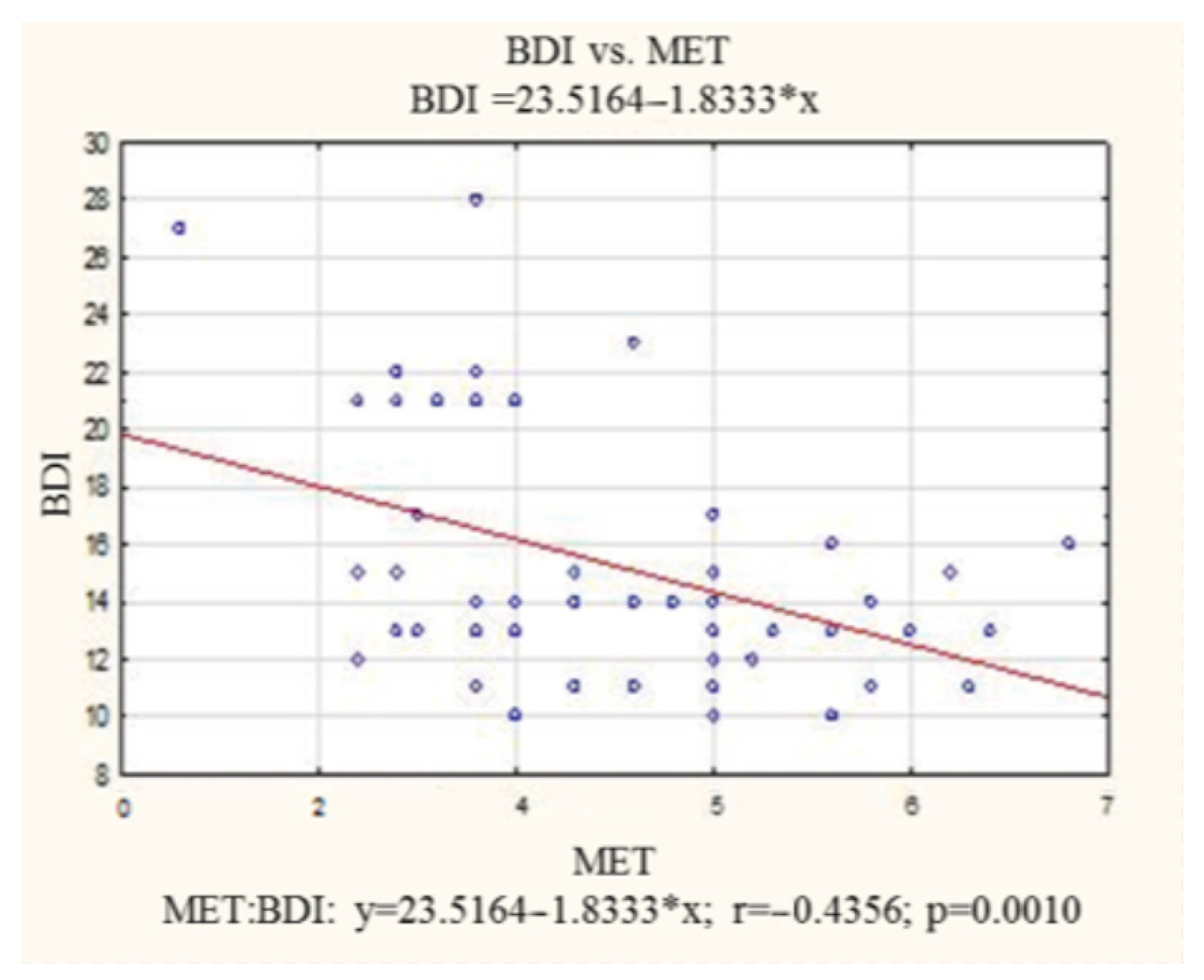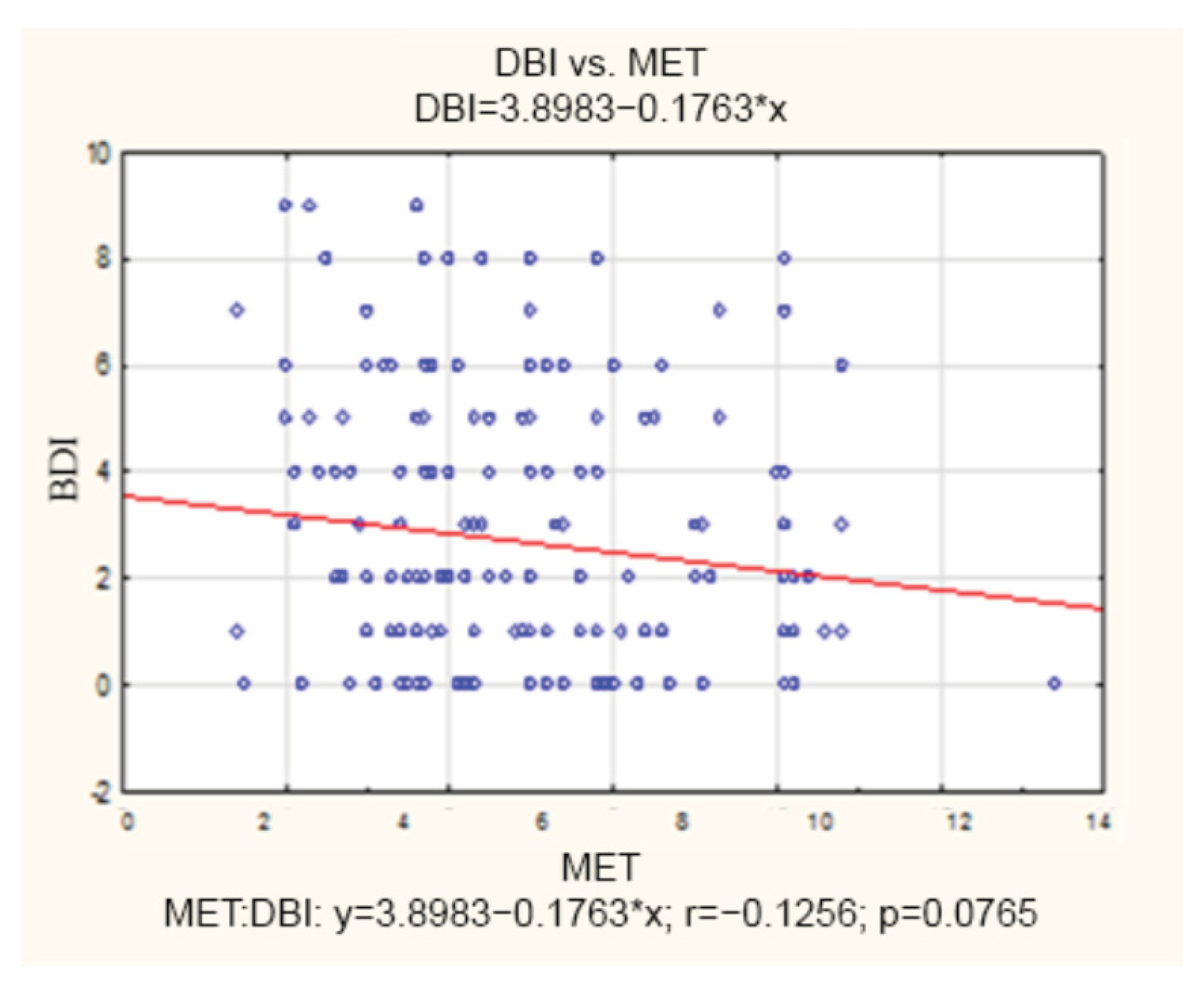Low Exercise Tolerance as a Marker of Erectile Dysfunction and Depression among Post-Myocardial Infarction Men
Abstract
1. Introduction
2. Materials and Methods
3. Results
4. Discussion
5. Conclusions
Author Contributions
Funding
Institutional Review Board Statement
Informed Consent Statement
Data Availability Statement
Conflicts of Interest
References
- Ujah, G.A.; Nna, V.U.; Agah, M.I.; Omue, L.O.; Leku, C.B.; Osim, E.E. Effect of Quercetin on Cadmium Chloride-Induced Impairments in Sexual Behaviour and Steroidogenesis in Male Wistar Rats. Andrologia 2018, 50, e12866. [Google Scholar] [CrossRef] [PubMed]
- Malviya, N.; Malviya, S.; Jain, S.; Vyas, S. A Review of the Potential of Medicinal Plants in the Management and Treatment of Male Sexual Dysfunction. Andrologia 2016, 48, 880–893. [Google Scholar] [CrossRef] [PubMed]
- Teoh, J.B.F.; Yee, A.; Danaee, M.; Ng, C.G.; Sulaiman, A.H.B. Erectile Dysfunction Among Patients on Methadone Maintenance Therapy and Its Association with Quality of Life. J. Addict. Med. 2017, 11, 40–46. [Google Scholar] [CrossRef] [PubMed]
- Schnatz, P.F.; Whitehurst, S.K.; O’Sullivan, D.M. Sexual Dysfunction, Depression, and Anxiety among Patients of an Inner-City Menopause Clinic. J. Womens Health 2010, 19, 1843–1849. [Google Scholar] [CrossRef]
- Eardley, I. The Incidence, Prevalence, and Natural History of Erectile Dysfunction. Sex. Med. Rev. 2013, 1, 3–16. [Google Scholar] [CrossRef]
- Przegląd Urologiczny—Zaburzenia Erekcji—Etiologia i Leczenie. Available online: http://www.przeglad-urologiczny.pl/artykul.php?1092 (accessed on 21 November 2022).
- Terentes-Printzios, D.; Ioakeimidis, N.; Rokkas, K.; Vlachopoulos, C. Interactions between Erectile Dysfunction, Cardiovascular Disease and Cardiovascular Drugs. Nat. Rev. Cardiol. 2022, 19, 59–74. [Google Scholar] [CrossRef]
- Tamrakar, D.; Bhatt, D.S.; Sharma, V.K.; Poudyal, A.K.; Yadav, B.K. Association Between Erectile Dysfunction and Type 2 Diabetes Mellitus. J. Nepal. Health Res. Counc. 2021, 19, 378–383. [Google Scholar] [CrossRef]
- Hudec, S.; Spacek, M.; Hutyra, M.; Moravec, O.; Taborsky, M. Sexual Activity and Cardiovascular Disease, Erectile Dysfunction as a Predictor of Ischemic Heart Disease. Cor Vasa 2018, 60, e296–e305. [Google Scholar] [CrossRef]
- Dursun, M.; Besiroglu, H.; Otunctemur, A.; Ozbek, E. Association between cardiometabolic index and erectile dysfunction: A new index for predicting cardiovascular disease. Kaohsiung J. Med. Sci. 2016, 32, 620–623. [Google Scholar] [CrossRef]
- Prabhakaran, D.K.; Nisha, A.; Varghese, P.J. Prevalence and Correlates of Sexual Dysfunction in Male Patients with Alcohol Dependence Syndrome: A Cross-Sectional Study. Indian J. Psychiatry 2018, 60, 71–77. [Google Scholar] [CrossRef]
- Gandaglia, G.; Briganti, A.; Jackson, G.; Kloner, R.A.; Montorsi, F.; Montorsi, P.; Vlachopoulos, C. A Systematic Review of the Association between Erectile Dysfunction and Cardiovascular Disease. Eur. Urol. 2014, 65, 968–978. [Google Scholar] [CrossRef] [PubMed]
- Raheem, O.A.; Su, J.J.; Wilson, J.R.; Hsieh, T.-C. The Association of Erectile Dysfunction and Cardiovascular Disease: A Systematic Critical Review. Am. J. Mens. Health 2017, 11, 552–563. [Google Scholar] [CrossRef] [PubMed]
- Virag, R.; Zwang, G.; Dermange, H.; Legman, M. Vasculogenic Impotence: A Review of 92 Cases with 54 Surgical Operations. Vasc. Surg. 1981, 15, 9–17. [Google Scholar] [CrossRef]
- Kirby, M. The Circle of Lifestyle and Erectile Dysfunction. Sex. Med. Rev. 2015, 3, 169–182. [Google Scholar] [CrossRef] [PubMed]
- Pastore, A.L.; Palleschi, G.; Ripoli, A.; Silvestri, L.; Maggioni, C.; Pagliuca, G.; Benedetti, F.M.N.; Gallo, A.; Zucchi, A.; Maurizi, A.; et al. Severe obstructive sleep apnoea syndrome and erectile dysfunction: A prospective randomised study to compare sildenafil vs. nasal continuous positive airway pressure. Int. J. Clin. Pract. 2014, 68, 995–1000. [Google Scholar] [CrossRef] [PubMed]
- Depression. Available online: https://www.who.int/news-room/fact-sheets/detail/depression (accessed on 21 November 2022).
- Bidzan, L. Depresyjne Zaburzenia Nastroju u Osób w Wieku Podeszłym. Med. Wieku Podeszłego 2011, 1, 31–41. [Google Scholar]
- Rhoden, E.L.; Telöken, C.; Sogari, P.R.; Vargas Souto, C.A. The Use of the Simplified International Index of Erectile Function (IIEF-5) as a Diagnostic Tool to Study the Prevalence of Erectile Dysfunction. Int. J. Impot. Res. 2002, 14, 245–250. [Google Scholar] [CrossRef]
- Beck, A.T.; Guth, D.; Steer, R.A.; Ball, R. Screening for Major Depression Disorders in Medical Inpatients with the Beck Depression Inventory for Primary Care. Behav. Res. Ther. 1997, 35, 785–791. [Google Scholar] [CrossRef]
- Jetté, M.; Sidney, K.; Blümchen, G. Metabolic Equivalents (METS) in Exercise Testing, Exercise Prescription, and Evaluation of Functional Capacity. Clin. Cardiol. 1990, 13, 555–565. [Google Scholar] [CrossRef]
- Franklin, B.A.; Brinks, J.; Berra, K.; Lavie, C.J.; Gordon, N.F.; Sperling, L.S. Using Metabolic Equivalents in Clinical Practice. Am. J. Cardiol. 2018, 121, 382–387. [Google Scholar] [CrossRef]
- Ainsworth, B.E.; Haskell, W.L.; Herrmann, S.D.; Meckes, N.; Bassett, D.R.; Tudor-Locke, C.; Greer, J.L.; Vezina, J.; Whitt-Glover, M.C.; Leon, A.S. 2011 Compendium of Physical Activities: A Second Update of Codes and MET Values. Med. Sci. Sports Exerc. 2011, 43, 1575–1581. [Google Scholar] [CrossRef] [PubMed]
- Yafi, F.A.; Jenkins, L.; Albersen, M.; Corona, G.; Isidori, A.M.; Goldfarb, S.; Maggi, M.; Nelson, C.J.; Parish, S.; Salonia, A.; et al. Erectile Dysfunction. Nat. Rev. Dis. Prim. 2016, 2, 16003. [Google Scholar] [CrossRef] [PubMed]
- Irwin, G.M. Erectile Dysfunction. Prim. Care 2019, 46, 249–255. [Google Scholar] [CrossRef] [PubMed]
- Grover, S.A.; Lowensteyn, I.; Kaouache, M.; Marchand, S.; Coupal, L.; DeCarolis, E.; Zoccoli, J.; Defoy, I. The Prevalence of Erectile Dysfunction in the Primary Care Setting: Importance of Risk Factors for Diabetes and Vascular Disease. Arch. Intern. Med. 2006, 166, 213–219. [Google Scholar] [CrossRef] [PubMed]
- Sasayama, S.; Ishii, N.; Ishikura, F.; Kamijima, G.; Ogawa, S.; Kanmatsuse, K.; Kimoto, Y.; Sakuma, I.; Nonogi, H.; Matsumori, A.; et al. Men’s Health Study: Epidemiology of Erectile Dysfunction and Cardiovascular Disease. Circ. J. 2003, 67, 656–659. [Google Scholar] [CrossRef] [PubMed]
- Kupelian, V.; Araujo, A.B.; Chiu, G.R.; Rosen, R.C.; McKinlay, J.B. Relative Contributions of Modifiable Risk Factors to Erectile Dysfunction: Results from the Boston Area Community Health (BACH) Survey. Prev. Med. 2010, 50, 19–25. [Google Scholar] [CrossRef]
- Booth, F.W.; Roberts, C.K.; Laye, M.J. Lack of Exercise Is a Major Cause of Chronic Diseases. Compr. Physiol. 2012, 2, 1143–1211. [Google Scholar] [CrossRef]
- Bacon, C.G.; Mittleman, M.A.; Kawachi, I.; Giovannucci, E.; Glasser, D.B.; Rimm, E.B. Sexual Function in Men Older than 50 Years of Age: Results from the Health Professionals Follow-up Study. Ann. Intern. Med. 2003, 139, 161–168. [Google Scholar] [CrossRef]
- Geniole, S.N.; Bird, B.M.; Ruddick, E.L.; Carré, J.M. Effects of Competition Outcome on Testosterone Concentrations in Humans: An Updated Meta-Analysis. Horm. Behav. 2017, 92, 37–50. [Google Scholar] [CrossRef]
- Esposito, K.; Giugliano, F.; Di Palo, C.; Giugliano, G.; Marfella, R.; D’Andrea, F.; D’Armiento, M.; Giugliano, D. Effect of Lifestyle Changes on Erectile Dysfunction in Obese Men: A Randomized Controlled Trial. JAMA 2004, 291, 2978–2984. [Google Scholar] [CrossRef]
- Paulsen, L.H.; Sørensen Bakke, L.; Jarbøl, D.E.; Balasubramaniam, K.; Hansen, D.G. Associations between Lifestyle, Erectile Dysfunction and Healthcare Seeking: A Population-Based Study. Scand. J. Prim. Health Care 2020, 38, 176–183. [Google Scholar] [CrossRef] [PubMed]
- Vane, J.R.; Anggård, E.E.; Botting, R.M. Regulatory functions of the vascular endothelium. N. Engl. J. Med. 1990, 323, 27–36. [Google Scholar] [CrossRef] [PubMed]
- Rinder, M.R.; Spina, R.J.; Ehsani, A.A. Enhanced endothelium-dependent vasodilation in older endurance-trained men. J. Appl. Physiol. (1985) 2000, 88, 761–766. [Google Scholar] [CrossRef] [PubMed]
- Chou, K.-L. Combined Effect of Vision and Hearing Impairment on Depression in Older Adults: Evidence from the English Longitudinal Study of Ageing. J. Affect. Disord. 2008, 106, 191–196. [Google Scholar] [CrossRef] [PubMed]
- Luppa, M.; König, H.-H.; Heider, D.; Leicht, H.; Motzek, T.; Schomerus, G.; Riedel-Heller, S.G. Direct Costs Associated with Depressive Symptoms in Late Life: A 4.5-Year Prospective Study. Int. Psychogeriatr. 2013, 25, 292–302. [Google Scholar] [CrossRef]
- Tani, Y.; Fujiwara, T.; Kondo, N.; Noma, H.; Sasaki, Y.; Kondo, K. Childhood Socioeconomic Status and Onset of Depression among Japanese Older Adults: The JAGES Prospective Cohort Study. Am. J. Geriatr. Psychiatry 2016, 24, 717–726. [Google Scholar] [CrossRef] [PubMed]
- Kim, J.-M.; Stewart, R.; Kim, S.-W.; Yang, S.-J.; Shin, I.-S.; Yoon, J.-S. Vascular Risk Factors and Incident Late-Life Depression in a Korean Population. Br. J. Psychiatry 2006, 189, 26–30. [Google Scholar] [CrossRef]
- Petersson, S.; Mathillas, J.; Wallin, K.; Olofsson, B.; Allard, P.; Gustafson, Y. Risk Factors for Depressive Disorders in Very Old Age: A Population-Based Cohort Study with a 5-Year Follow-Up. Soc. Psychiatry Psychiatr. Epidemiol. 2014, 49, 831–839. [Google Scholar] [CrossRef]
- Maier, A.; Riedel-Heller, S.G.; Pabst, A.; Luppa, M. Risk Factors and Protective Factors of Depression in Older People 65+. A Systematic Review. PLoS ONE 2021, 16, e0251326. [Google Scholar] [CrossRef]
- Teychenne, M.; Ball, K.; Salmon, J. Physical Activity and Likelihood of Depression in Adults: A Review. Prev. Med. 2008, 46, 397–411. [Google Scholar] [CrossRef]
- Mammen, G.; Faulkner, G. Physical Activity and the Prevention of Depression: A Systematic Review of Prospective Studies. Am. J. Prev. Med. 2013, 45, 649–657. [Google Scholar] [CrossRef] [PubMed]
- Kim, S.-Y.; Park, J.-H.; Lee, M.Y.; Oh, K.-S.; Shin, D.-W.; Shin, Y.-C. Physical Activity and the Prevention of Depression: A Cohort Study. Gen. Hosp. Psychiatry 2019, 60, 90–97. [Google Scholar] [CrossRef] [PubMed]
- Seidman, S.N. Exploring the Relationship between Depression and Erectile Dysfunction in Aging Men. J. Clin. Psychiatry 2002, 63 (Suppl. 5), 5–12; discussion 23–25. [Google Scholar]
- Ma, K.; Song, P.; Liu, Z.; Yang, L.; Wang, L.; Zhou, J.; Chen, J.; Dong, Q. Genetic Evidence Suggests That Depression Increases the Risk of Erectile Dysfunction: A Mendelian Randomization Study. Front. Genet. 2022, 13, 1026227. [Google Scholar] [CrossRef]
- Goldstein, I. The Mutually Reinforcing Triad of Depressive Symptoms, Cardiovascular Disease, and Erectile Dysfunction. Am. J. Cardiol. 2000, 86, 41F–45F. [Google Scholar] [CrossRef]
- Hong, Z.; Chen, Z.; Feng, J.; Wang, S.; Qiu, J.; Zeng, Y.; Wang, Q.; Wang, J. Mechanistic Analysis of Erectile Dysfunction in a Depression Rat Model. J. Int. Med. Res. 2022, 50, 1–14. [Google Scholar] [CrossRef] [PubMed]
- Atlantis, E.; Sullivan, T. Bidirectional Association between Depression and Sexual Dysfunction: A Systematic Review and Meta-Analysis. J. Sex. Med. 2012, 9, 1497–1507. [Google Scholar] [CrossRef]



| Clinical Data | Study Group n (%) |
|---|---|
| Height (m) | 1.73 ± 0.06 |
| Weight (kg) | 84.36 ± 12.44 |
| BMI (kg/m2) | 28.10 ± 3.73 |
| Waist circumference (cm) | 98.56 ± 11.51 |
| Overweight and obesity | 203 (79.92%) |
| Hypertension | 54 (21.26%) |
| Diabetes type 2 | 103 (40.55%) |
| Lipid disorders | 149 (58.66%) |
| Smoking now | 14 (5.51%) |
| Smoking in the past | 208 (81.89%) |
| Cigarettes per day | 20.16 ± 8.38 |
| Pack years | 46.09 ± 21.43 |
| Sedentary lifestyle | 223 (87.80%) |
| LTPA + | 31 (12.20%) |
| LTPA (any activity) | 117 (87.80%) |
| Mean LTPA (kcal/week) | 798.13 ± 403.98 |
| Creatinine | 1.04 ± 0.53 |
| HGB | 13.1 ± 1.67 |
| Potassium | 4.31 ± 0.39 |
| Glucose | 108.1 ± 34.13 |
| CHOL | 148 ± 38.63 |
| TRIGL | 123.5 ± 65.29 |
| HDL | 42.16 ± 10.34 |
| LDL | 81.1 ± 30.05 |
| Atrial fibrillation | 38 (14.96%) |
| Myocardial infarction | 254 (100%) |
| PTCA | 170 (68.55%) |
| CABG | 115 (46.37%) |
| Clinical Data | Study Group n (%) |
|---|---|
| MET before rehabilitation | 6.39 ± 1.94 |
| MET after rehabilitation | 7.43 ± 2.16 |
| n | Depression * | No Depression * | p-Value | ED | Non-ED | p-Value | ||
|---|---|---|---|---|---|---|---|---|
| BMI | ≥25 | 203 | 43 | 160 | 0.96 | 103 | 20 | 0.99 |
| <25 | 51 | 11 | 40 | 46 | 5 | |||
| Lipid disorders | yes | 149 | 31 | 118 | 0.83 | 133 | 16 | 0.57 |
| no | 105 | 23 | 82 | 96 | 9 | |||
| Smoking in the past | yes | 208 | 50 | 158 | 0.02 | 190 | 18 | 0.18 |
| no | 46 | 4 | 42 | 39 | 7 | |||
| Smoking now | yes | 14 | 2 | 12 | 0.18 | 12 | 2 | 0.77 |
| no | 240 | 23 | 217 | 217 | 23 | |||
| Hypertension | yes | 200 | 43 | 157 | 0.86 | 177 | 23 | 0.35 |
| no | 54 | 11 | 43 | 52 | 2 | |||
| Diabetes mellitus | yes | 103 | 36 | 67 | 0.00001 | 98 | 5 | 0.03 |
| no | 151 | 18 | 133 | |||||
| n | ED | Non-ED | p-Value | ||
|---|---|---|---|---|---|
| BMI | ≥25 | 203 | 103 | 20 | 0.99 |
| <25 | 51 | 46 | 5 | ||
| Lipid disorders | yes | 149 | 133 | 16 | 0.57 |
| no | 105 | 96 | 9 | ||
| Smoking in the past | yes | 208 | 190 | 18 | 0.18 |
| no | 46 | 39 | 7 | ||
| Smoking now | yes | 14 | 12 | 2 | 0.77 |
| no | 240 | 217 | 23 | ||
| Hypertension | yes | 200 | 177 | 23 | 0.35 |
| no | 54 | 52 | 2 | ||
| Diabetes mellitus | yes | 103 | 98 | 5 | 0.03 |
| no | 151 | 131 | 20 | ||
Disclaimer/Publisher’s Note: The statements, opinions and data contained in all publications are solely those of the individual author(s) and contributor(s) and not of MDPI and/or the editor(s). MDPI and/or the editor(s) disclaim responsibility for any injury to people or property resulting from any ideas, methods, instructions or products referred to in the content. |
© 2023 by the authors. Licensee MDPI, Basel, Switzerland. This article is an open access article distributed under the terms and conditions of the Creative Commons Attribution (CC BY) license (https://creativecommons.org/licenses/by/4.0/).
Share and Cite
Mandera-Grygierzec, A.; Kostrzewska, P.; Szuster, E.; Pawlikowska-Gorzelańczyk, A.; Biernikiewicz, M.; Rusiecka, A.; Mrozek-Szetela, A.; Sobieszczańska, M.; Rożek-Piechura, K.; Markiewicz, M.; et al. Low Exercise Tolerance as a Marker of Erectile Dysfunction and Depression among Post-Myocardial Infarction Men. Healthcare 2023, 11, 1213. https://doi.org/10.3390/healthcare11091213
Mandera-Grygierzec A, Kostrzewska P, Szuster E, Pawlikowska-Gorzelańczyk A, Biernikiewicz M, Rusiecka A, Mrozek-Szetela A, Sobieszczańska M, Rożek-Piechura K, Markiewicz M, et al. Low Exercise Tolerance as a Marker of Erectile Dysfunction and Depression among Post-Myocardial Infarction Men. Healthcare. 2023; 11(9):1213. https://doi.org/10.3390/healthcare11091213
Chicago/Turabian StyleMandera-Grygierzec, Amanda, Paulina Kostrzewska, Ewa Szuster, Anna Pawlikowska-Gorzelańczyk, Małgorzata Biernikiewicz, Agnieszka Rusiecka, Aneta Mrozek-Szetela, Małgorzata Sobieszczańska, Krystyna Rożek-Piechura, Monika Markiewicz, and et al. 2023. "Low Exercise Tolerance as a Marker of Erectile Dysfunction and Depression among Post-Myocardial Infarction Men" Healthcare 11, no. 9: 1213. https://doi.org/10.3390/healthcare11091213
APA StyleMandera-Grygierzec, A., Kostrzewska, P., Szuster, E., Pawlikowska-Gorzelańczyk, A., Biernikiewicz, M., Rusiecka, A., Mrozek-Szetela, A., Sobieszczańska, M., Rożek-Piechura, K., Markiewicz, M., & Kałka, D. (2023). Low Exercise Tolerance as a Marker of Erectile Dysfunction and Depression among Post-Myocardial Infarction Men. Healthcare, 11(9), 1213. https://doi.org/10.3390/healthcare11091213












